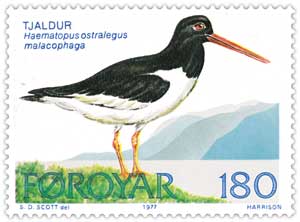Spring quarter started this week, and one of the (three) classes I'm taking is Faroese Literature. We're lucky to have a visiting Fullbright professor from the Faroe Islands. Malan Marnersdóttir usually teaches at the University of the Faroes in Tórshavn; she's spending the Spring in Seattle to teach and conduct research. The course syllabus is online here (PDF).
You can see four of the books we're reading here, although a larger number of excerpted texts are in our course reader. (I always intend to go back and purchase (preferably used) copies of the books which exist only in xeroxed reader packets -- perhaps that's a summer project in the making.)
So far, Malan has basically been giving us an introduction to the history of the Faroes, as well as the cultural background for the literature we'll be reading. Some items of note:
Merkið, (cognate with English the mark) is the Faroese flag, designed in 1919 but not given official sanction until April 25th, 1940. Ironically, the approval was by the occupation British authorities, who had siezed control of the islands after the fall of Denmark to Hitler's troops. Faroese ships couldn't fly Danish flags for risk of being bombed by the RAF -- as the rest of Denmark was under the control of the Germans. Thus, ships sailing from Tórshavn were granted permission to fly what would have been in other circumstances a politically-charged banner. Here, the first 'merkið' hangs in Fámjin church:

The Faroese national bird is the tjaldur (Haematopus ostralegus, Eurasian Oystercatcher). The origins of this decision date to a satrical ballad (táttur) written by Poul Nólsoy in 1806, attacking the corruption of the Danish crown servents who administered the Royal Trade Monopoly between Tórshavn and Copenhagen. Fuglakvæðið, as it was known, was an allegory about the tjaldur who warns others of danger by making a sharp, piercing cry. Nowadays philately has gotten the oystercatcher a stamp of its own:

Some of the few scraps of medieval Faroese culture we have are proverbs and sayings, including:
Fram kemur hann ið hóvliga fer
Forward comes he in careful faring
≈ Slow & steady wins the race